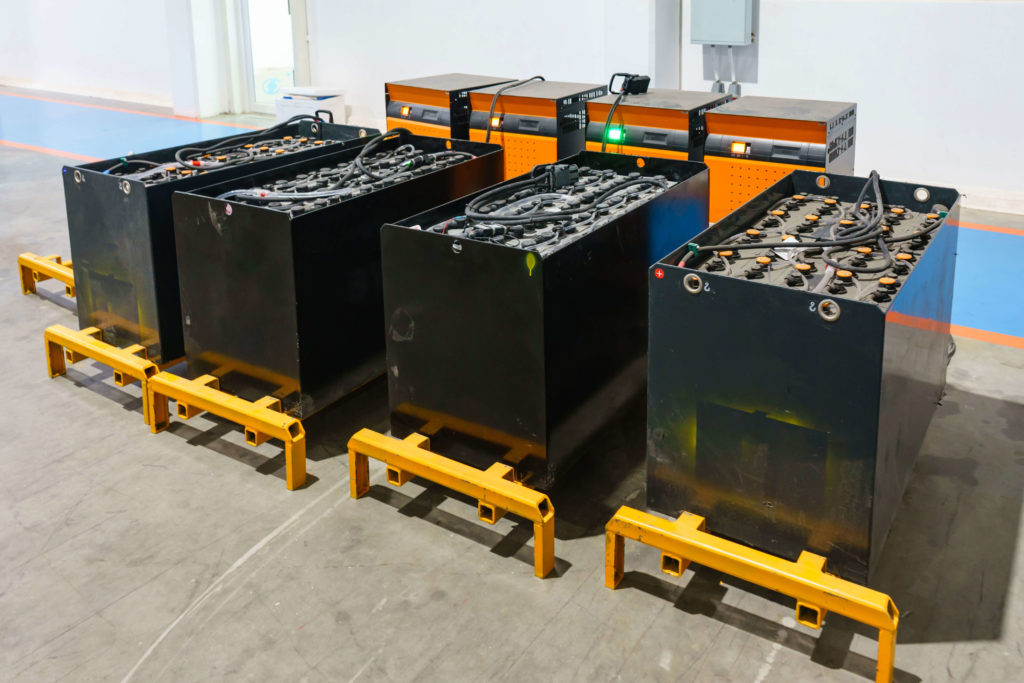IS IT TIME TO REPLACE THE BATTERY IN YOUR FORKLIFT?

HOW TO CHOOSE WHICH BATTERY IS BEST FOR YOUR FORKLIFT
TRADITIONAL LEAD ACID, SEALED LEAD ACID, OR LITHIUM ION?
Forklift batteries come in many different shapes, sizes, and types. Choosing the best option for your forklift and warehouse is crucial to ensuring an effective, efficient, and safe operation. The question is, how do you know which type of forklift battery is right for you? And if you already have a forklift, is it possible to replace the battery with a different type?
In this blog post, we go over the different types of forklift batteries, forklift battery replacement, and how to determine which one is best for your needs.
The different types of forklift batteries
There are three primary types of forklift batteries available, and each has several benefits and drawbacks.
Flooded wet cell lead acid – This battery is the most common one found in forklifts and the most traditional. It works by suspending charged plates in a mixture of sulfuric acid and water called electrolyte. Evaporation occurs during operation and charging, meaning that water must be regularly added.
Sealed lead acid – These batteries operate the same way as traditional lead acid batteries, but are sealed at the top, meaning they won’t leak acid and will not exhaust gas during charging or operation in normal conditions. A sealed lead acid forklift battery does not need to have water added regularly.
Lithium ion – Lithium ion batteries are the newest type of forklift battery technology. They consist of single or multiple lithium ion cells separated by a liquid or gel electrolyte. These batteries are sealed, do not need watering, and require very little maintenance.
Benefits and drawbacks of each type of forklift battery
When it comes to choosing the best forklift battery replacement for your needs, you have to take a close look at the three primary options and what they offer.
For traditional lead acid forklift batteries, the main advantage is its price. They are about 2.5 to 3 times less expensive than a lithium ion battery. The drawbacks, however, are that they require regular maintenance (adding water), they can be relatively easily damaged if they are not watered or charged correctly, and they will create dangerous situations if their battery acid is spilled. Plus, lead acid forklift batteries take longer to charge; the usual cycle is an 8 hour run time, 8 hour charge time, and 8 hour cooling time.
Though similar to traditional lead acid options, a sealed lead acid forklift battery is typically a little more expensive, but you can cut down on maintenance by eliminating the need to regularly water it. In addition to less maintenance, with sealed batteries you are not exposing operators to battery acid or potential spills.
Lithium ion forklift batteries take the benefits of sealed lead acid options even further. They are very low maintenance and eliminate the chance of battery acid accidents. Some of the most important benefits of choosing lithium ion, however, are its capacity and short charging time.
You can run lithium ion batteries all the way down, whereas lead acid batteries should not be depleted lower than 20% power. Plus, you can put 100% of the power back into the battery within an hour. You also don’t have to worry about damage or repair costs if the watering isn’t completed exactly as required, over or under charging it, or over or under using it, like you do with lead acid batteries. The downside is that lithium ion forklift batteries are much more expensive.
How to determine which forklift battery replacement is best for you
The type of battery you depends on what’s best for your specific operation. At JIT, we can retrofit any forklift with essentially any type of battery, lead acid or lithium ion. If it gives the machine adequate voltage and power, it will work. But not every warehouse or set up can justify the higher cost of lithium ion forklift batteries.
For example, lithium ion is great for operations that have multiple shifts back to back without a lot of downtime in between. They have enough capacity to use across multiple shifts and can be fully recharged in only an hour. With a lead acid forklift battery, you’ll need a different battery for each shift. There are fast chargers available, but you have to be careful to use the right cables and leave enough time for cooling to avoid damage.
The watering and charging of lead acid batteries is where most people fail and cause problems. Lithium ion batteries can eliminate those potential issues. On the other hand, if you have adequate time to maintain and charge your forklift battery correctly, then the higher cost of a lithium ion option may not be worth it.
Still don’t know which one to choose? JIT can help
At JIT, we have several forklift battery replacement experts who have advanced tools and knowledge to ensure you pick the right one. We look at your specific usage, like how hard you are running your forklift and for how long, and at your operation, like number of shifts and amount of downtime, to determine which battery and which charger are best for your particular needs.
We have a lot of options available, and we have extensive experience finding people the right forklift battery replacement. Whether it’s traditional lead acid, sealed lead acid, or lithium ion, we help you put the right one in your machine.
Contact JIT for your forklift battery replacement today!
